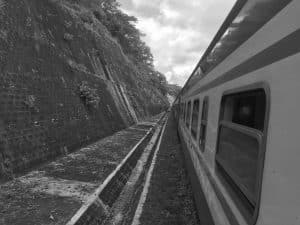Introduction to the Tanga Line
The Tanga Line, also known as the Usambara Railway, is a narrow-gauge railway that connects the coastal city of Tanga to the inland town of Moshi. Constructed during the German colonial era in the late 19th century, this railway line played a vital role in the economic and social development of the region, facilitating the transportation of goods, resources, and people.
Today, the Tanga Line continues to be an important mode of transportation for locals and visitors alike, offering a leisurely and scenic way to explore the northern regions of Tanzania. Whether you’re interested in history, culture, or simply taking in the breathtaking natural scenery, the Tanga Line is a must-visit destination for any traveler to Tanzania.
History and Significance of the Tanga Line
The Tanga Line was first conceived in the late 1800s as part of the German colonial administration’s efforts to establish a reliable transportation network in the region. Construction on the railway began in 1893 and was completed in 1912, connecting the coastal town of Tanga to the inland town of Moshi, a distance of approximately 300 kilometers.
The Tanga Line was not only a significant engineering feat but also played a crucial role in the economic and social development of the region. The railway facilitated the transportation of agricultural products, such as sisal, coffee, and cotton, from the interior to the coast, where they could be exported. It also enabled the movement of people, goods, and resources, fostering greater economic and cultural exchange between the coastal and inland communities.
During the colonial era, the Tanga Line was an important symbol of German power and influence in the region. However, after Tanzania gained independence in 1961, the railway line continued to serve as a vital transportation link, connecting communities and supporting the country’s economic growth.
Exploring the Route of the Tanga Line

The Tanga Line winds its way through the stunning landscapes of northern Tanzania, offering travelers a unique and unforgettable experience. The journey begins in the coastal city of Tanga, where the railway station serves as a gateway to the region’s rich cultural heritage and natural wonders.
As the train departs Tanga, it slowly climbs through the rolling hills and lush forests of the Usambara Mountains, offering breathtaking views of the surrounding countryside. Along the way, the train passes through several small towns and villages, each with its own distinct character and cultural traditions.
One of the highlights of the Tanga Line journey is the crossing of the Pangani River, which is spanned by a impressive steel bridge. This engineering marvel, constructed during the German colonial era, is a testament to the ingenuity and determination of the railway’s builders.
As the train continues its journey inland, it winds through the fertile agricultural regions of the Kilimanjaro and Meru districts, passing by vast coffee and sisal plantations. The final destination, the town of Moshi, is nestled at the base of the majestic Mount Kilimanjaro, the highest freestanding mountain in the world.
Highlights and Attractions along the Tanga Line
The Tanga Line journey is rich with cultural and natural attractions that offer travelers a truly immersive experience. Along the way, you’ll have the opportunity to explore historic towns, visit local markets, and marvel at the stunning natural scenery.
One of the must-see attractions along the Tanga Line is the Lushoto town, a charming community nestled in the heart of the Usambara Mountains. This picturesque town is known for its traditional architecture, vibrant markets, and stunning views of the surrounding peaks.
Another highlight of the Tanga Line journey is the Amani Nature Reserve, a protected area that is home to a diverse array of plant and animal life. Visitors can explore the reserve’s hiking trails, spot a variety of bird species, and learn about the region’s unique ecosystem.
As you continue your journey, you’ll also have the chance to visit the Vugiri Falls, a stunning waterfall that cascades over the rugged landscape, and the Nduruma River, a popular spot for birdwatching and outdoor recreation.
Cultural and Historical Sites near the Tanga Line
The Tanga Line not only offers breathtaking natural scenery but also a rich cultural and historical heritage. Along the route, you’ll have the opportunity to visit a number of significant sites that provide insights into the region’s past.
One of the most notable cultural attractions is the Kilindi Palace, a former royal residence that now serves as a museum showcasing the history and traditions of the Kilindi people. Visitors can explore the palace’s ornate architecture, learn about the region’s history, and immerse themselves in the local culture.
Another must-see destination is the Magila Monastery, a historic religious site that dates back to the 19th century. This impressive stone structure is a testament to the region’s religious diversity and is a popular pilgrimage site for both Christians and Muslims.
In addition to these cultural landmarks, the Tanga Line also passes through several traditional villages, where you can interact with local residents, learn about their way of life, and purchase handcrafted goods and souvenirs.
Wildlife and Nature Experiences near the Tanga Line
The Tanga Line traverses some of the most biodiverse regions of Tanzania, offering travelers a unique opportunity to experience the country’s rich natural heritage. Along the route, you’ll have the chance to spot a variety of wildlife, explore pristine forests, and immerse yourself in the stunning landscapes.
One of the must-visit destinations for nature enthusiasts is the Mkomazi National Park, a protected area that is home to a diverse array of plant and animal species. Visitors can embark on guided safaris to spot elephants, giraffes, and a variety of antelope, as well as explore the park’s rugged terrain and lush vegetation.
Another highlight for nature lovers is the Usambara Mountains, a stunning mountain range that is home to a rich array of endemic plant and animal species. Visitors can hike through the mountains, explore the region’s diverse ecosystems, and enjoy breathtaking views of the surrounding landscape.
For those interested in birdwatching, the Tanga Line offers numerous opportunities to spot a variety of avian species, including the rare and elusive Usambara eagle-owl. The region’s diverse habitats, from wetlands to forests, provide a rich and varied birdlife for enthusiasts to discover.
Tips for Visiting the Tanga Line
Exploring the Tanga Line is a unique and unforgettable experience, but it’s important to be prepared for the journey. Here are some tips to help you make the most of your visit:
- Plan your trip in advance: The Tanga Line operates on a limited schedule, so it’s important to plan your trip in advance to ensure that you can take the train on your desired dates.
- Pack appropriate clothing and gear: The weather in northern Tanzania can be quite variable, so be sure to pack a variety of clothing, including layers, comfortable walking shoes, and sun protection.
- Bring snacks and water: The train journey can be lengthy, so it’s a good idea to pack some snacks and water to keep you refreshed and energized.
- Be prepared for delays: As with any mode of transportation, the Tanga Line can experience occasional delays or schedule changes, so be prepared to be flexible and patient.
- Engage with local communities: Take the time to interact with the local communities along the Tanga Line, as this can provide a deeper understanding and appreciation of the region’s culture and traditions.
- Consider a guided tour: While it’s possible to explore the Tanga Line on your own, a guided tour can provide valuable insights and help you make the most of your experience.
Accommodation Options along the Tanga Line
Travelers exploring the Tanga Line will find a variety of accommodation options to suit their needs and budgets. In the larger towns and cities along the route, you’ll find a range of hotels, guesthouses, and lodges that cater to both budget-conscious and luxury-seeking travelers.
For a more authentic and immersive experience, consider staying in one of the traditional villages or eco-lodges located near the Tanga Line. These accommodations offer the opportunity to experience the local culture and connect with the surrounding natural environment.
Regardless of your preferred accommodation, it’s important to book your stay in advance, as the Tanga Line is a popular destination, particularly during the peak tourism season.
Transportation Options to Reach the Tanga Line
Accessing the Tanga Line is relatively straightforward, with a variety of transportation options available to suit your needs and preferences.
If you’re starting your journey in Dar es Salaam or another coastal city, you can take a bus or private transfer to the Tanga railway station, which serves as the starting point for the Tanga Line journey. Alternatively, you can fly into Kilimanjaro International Airport, located near the Moshi terminus of the Tanga Line, and then arrange for a transfer or local transportation to reach the railway.
Once you’ve arrived at the Tanga Line, you can purchase your train tickets and embark on the scenic journey through northern Tanzania. Keep in mind that the Tanga Line operates on a limited schedule, so it’s important to plan your travel accordingly.
Conclusion: Exploring the Beauty of the Tanga Line in Tanzania

The Tanga Line is a true gem of northern Tanzania, offering travelers a unique and unforgettable experience that combines the region’s rich cultural heritage, stunning natural beauty, and historic significance. Whether you’re interested in history, nature, or simply seeking a leisurely and scenic journey, the Tanga Line is a must-visit destination that will leave a lasting impression.
For more articles related to Railway and train travel Tanzania, click here!

































